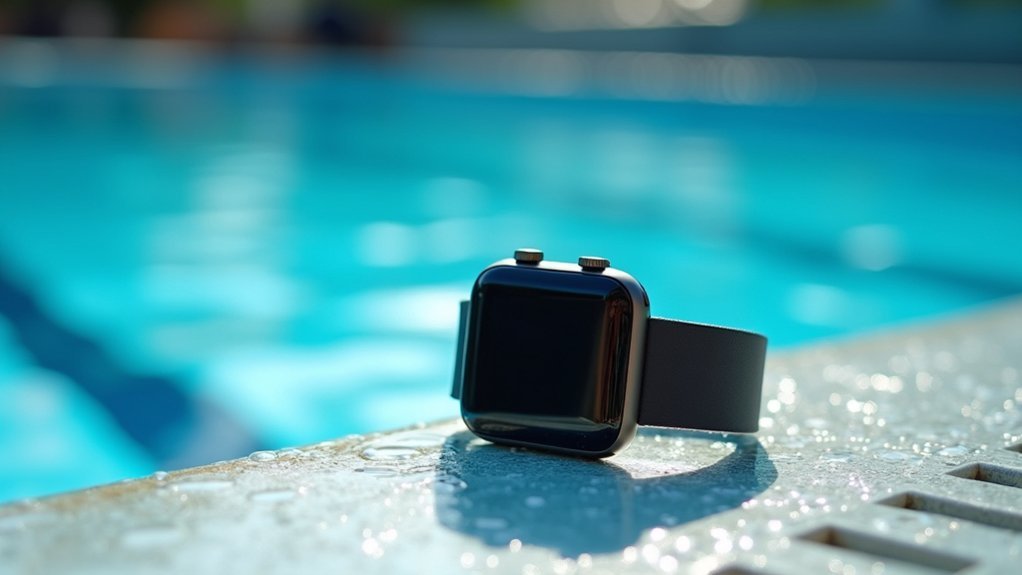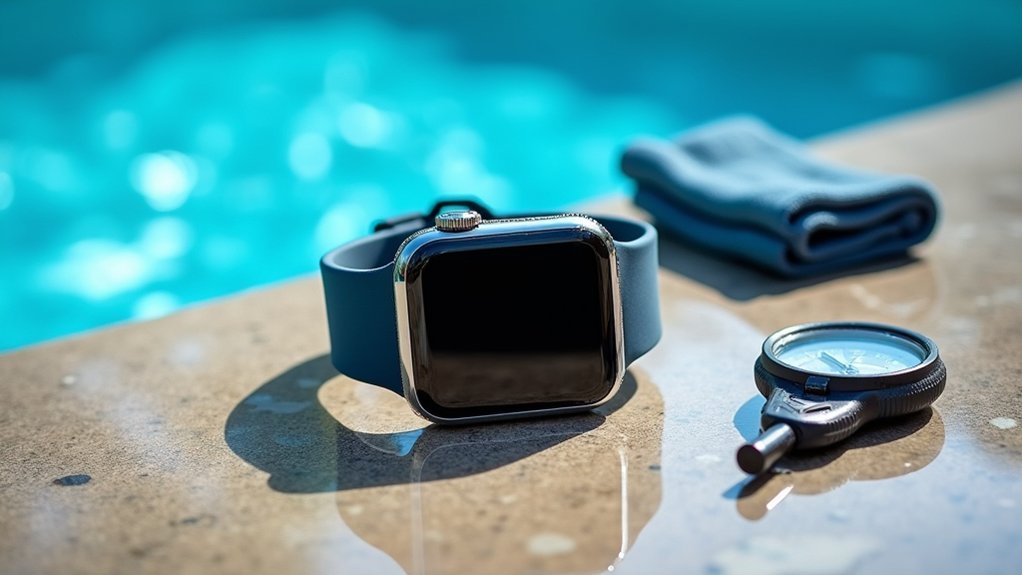You need a minimum 10 ATM (100m) water resistance rating for swimming—don’t be fooled by 50m ratings that only handle splashes. Look for ISO 6425 certification, which guarantees extensive testing at 125% of the rated depth. Check for essential construction features like sealed case backs with O-ring gaskets, reinforced sapphire crystal faces, and secure straps. Schedule professional water-resistance testing every two years since gaskets naturally deteriorate, and the detailed guide below reveals additional critical factors.
Understanding Water Resistance Ratings and Standards for Swimming Activities

When you’re shopping for a swim watch, understanding water resistance ratings becomes crucial since these numbers determine whether your timepiece can handle pool laps or ocean swims.
You’ll see ratings in bars, ATM, meters, or feet – where 1 ATM equals roughly 10 meters of static water pressure. Don’t be fooled by the depth numbers though; a 50m rating doesn’t mean you can safely dive that deep.
For actual swimming, you’ll need at least 10 ATM (100m) resistance, which handles swimming and snorkeling. Watches with 3-5 ATM only resist splashes and everyday exposure.
If you’re serious about diving, look for ISO 6425 certification, which guarantees thorough testing at 125% of rated depth with additional safety features like screw-down crowns. Watch manufacturers typically use dry testing methods that increase pressure in a chamber without water to keep the movement safe during evaluation.
Essential Features and Construction Elements for Reliable Swim Watches
Beyond water resistance ratings, your swim watch’s core features and construction quality determine whether it’ll deliver accurate data and withstand countless pool sessions.
A swim watch’s true value lies in its core features and build quality, not just its water resistance rating.
You’ll want GPS tracking for open water swimming and accurate stroke detection that analyzes your technique. Heart rate monitoring helps you track exertion levels while SWOLF measurements assess your swimming efficiency.
Construction-wise, look for sealed case backs with O-ring gaskets that prevent water entry. Reinforced crystal faces made from synthetic sapphire resist scratches, while high-quality seals maintain integrity under pressure.
Choose watches with comfortable, secure straps and lightweight profiles for extended wear. Memory storage lets you review multiple swim sessions, and chronograph functions provide detailed timing. Elite watches should feature a waterproof rating of 10ATM or higher for serious swimming and diving activities.
These elements together create a reliable swimming companion.
Maintenance and Testing Requirements to Preserve Waterproof Performance

Even the highest-quality swim watch won’t maintain its waterproof integrity without proper care and regular maintenance.
You’ll need professional water-resistance testing every two years, as gaskets naturally deteriorate and ratings aren’t permanent. Always test before swimming, especially after servicing or battery replacement.
Handle your watch carefully by avoiding crown manipulation when wet and never exposing it to hot tubs, chemicals, or direct faucet pressure. For chronograph models, ensure you never press pushers when the watch is underwater or wet, as this can compromise water resistance.
After saltwater exposure, rinse with fresh water immediately. Clean regularly with a soft cloth to remove sweat and dirt that degrades seals.
Schedule servicing every two to three years for gasket inspection and replacement.
Monitor for condensation inside the crystal—it’s an immediate warning sign that seals have failed and require professional attention.
Frequently Asked Questions
Can I Wear My Swim Watch in a Hot Tub or Sauna?
You shouldn’t wear your swim watch in hot tubs or saunas. Heat and chemicals can damage waterproof seals, reducing water resistance over time. Most manufacturers explicitly warn against exposure to heated environments.
How Much Should I Expect to Spend on a Quality Swim Watch?
You’ll spend $100-200 for basic swim tracking, $250-500 for mid-range features like stroke detection, or $600-1,000+ for premium models with advanced analytics and multisport capabilities.
Which Brands Offer the Best Warranty Coverage for Swim Watches?
You’ll find Suunto and Casio G-Shock offer the best coverage with 2-year warranties covering water resistance failures. Garmin provides solid 1-year coverage, while Apple’s AppleCare+ extends protection considerably for swim users.
Do Smartwatches With Fitness Tracking Work Well for Swimming?
You’ll find smartwatches work decently for swimming with stroke counting and basic metrics, but dedicated swim watches offer superior accuracy. Confirm your device has 5ATM water resistance minimum for reliable pool performance.
Can I Use My Swim Watch for Saltwater and Chlorinated Pool Swimming?
You can use your swim watch in both saltwater and chlorinated pools if it has a 5ATM or higher water resistance rating. You’ll need regular cleaning afterward to prevent damage from chemicals and salt.
In Summary
You’ll protect your investment by selecting swim watches with appropriate ATM ratings, prioritizing quality seals and construction materials, and maintaining proper care routines. Don’t overlook regular pressure testing and gasket inspections—they’re vital for long-term waterproof reliability. Remember that even the best swim watch won’t perform indefinitely without maintenance. By following these three essential tips, you’ll guarantee your timepiece withstands countless swimming sessions while delivering accurate performance both in and out of the water.





Leave a Reply